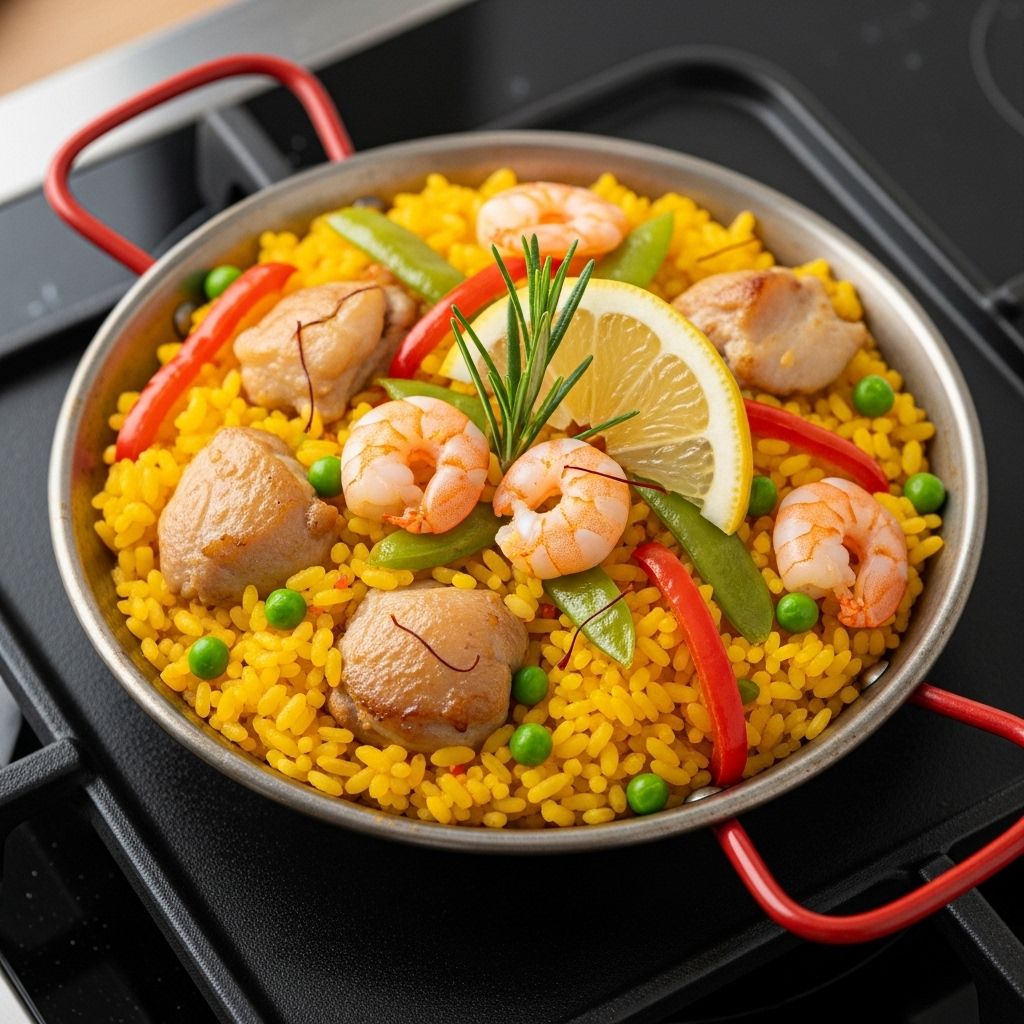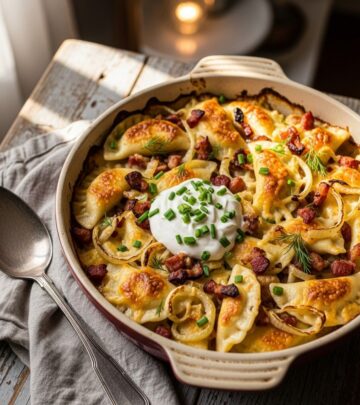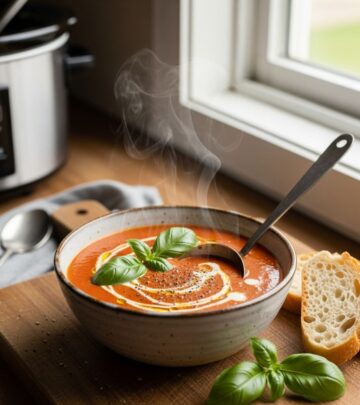The Secret to Perfect Stovetop Paella: Think Small
Unlock classic Spanish flavor at home by mastering perfectly cooked stovetop paella in smaller pans.

For many home cooks, paella—the iconic Spanish rice dish—can seem both enticing and intimidating. The images of vast, saffron-scented rice pans festooned with seafood and crisped to golden perfection conjure up scenes straight from Spanish mercados or Valencia’s bustling plazas. But what if you want that magic at home and only have a stovetop to work with? The essential trick: go small. This guide demystifies the stovetop paella, showing how pan size, simple techniques, and a bold approach yield authentic results in a home kitchen.
Why Traditional Paella Is Tricky at Home
Traditional paella relies on an evenly spreading heat source, like a wood-fired flame or wide ring burner, to cook a broad, shallow pan of rice. Home kitchens, however, present a unique challenge:
- Most stovetops have burners that heat only a small area.
- Standard paella pans are much wider than the flame can reach—leading to uneven cooking.
- Attempting a full-size paella on your stovetop often results in burnt edges and an undercooked center.
So how can you adapt paella to the home, without sacrificing its signature flavors and textures?
The Smaller, The Better: Pan Size Matters
The most critical decision for stovetop paella is the pan size. The wider your pan, the thinner the rice layer—but also, the trickier to heat evenly over a single burner.
- Ideal size: For stovetops, use pans no wider than 10 to 12 inches (26 to 30 cm) in diameter.
- A 10-inch pan is perfect for 2–3 servings, making it easier to achieve even cooking.
- Paella pans vs. other pans: A real carbon steel paella pan is optimal, but a large stainless steel skillet or shallow sauté pan can work in a pinch.
With smaller pans, the flame covers almost the entire bottom, ensuring each grain of rice cooks evenly.
The One-Layer Rule: Rice Thickness Is Everything
Paella is not meant to be a volume dish. Its glory lies in a single, thin bed of rice—tender throughout, with a prized, crispy bottom crust called socarrat. Cramming in too much rice sabotages this delicate balance.
- Golden ratio: Aim for a rice layer no more than 1/2 inch (1 cm) thick.
- For a 10-inch pan, 1 cup (about 200g) of raw short-grain rice is perfect.
This shallow layer allows the rice to absorb just enough liquid, resulting in explosively flavorful grains and a lovely crust.
Paella Rice: Choose Short-Grain for Best Results
The rice is the soul of paella. Its unique ability to soak up delicious broth without getting mushy sets paella apart from risotto or pilaf. Here’s what you need to know:
- Best choices: Bomba or Calasparra rice (from Spain) are the gold standard—short-grain, absorbent, and forgiving.
- Alternatives: Italian Arborio rice works well; Japanese sushi rice can also substitute if rinsed well.
- Don’t use: Long-grain rice (like basmati or jasmine) or sticky rice—they won’t yield proper texture.
Building Layers of Flavor: The Foundations of Paella
Paella’s flavor complexity comes from a carefully crafted base. Before adding rice, take the time to develop richness using these core steps:
Sofrito: The Aromatic Base
- Start with onions and garlic, gently sautéed until soft and golden.
- Add diced tomatoes (fresh or canned), cooking until thick and jammy.
- For extra savor, add grated bell pepper, a pinch of smoked paprika, or a few diced mushrooms.
Stock: The Liquid Gold
- Homemade or high-quality store-bought chicken, seafood, or vegetable stock elevates your paella.
- For authentic flavor, infuse stock with a pinch of saffron and a bay leaf while heating it before use.
Proteins: Chicken, Seafood, or Vegan
- Brown seasoned chicken, rabbit, or sausage in oil—remove, then proceed with soffrito in the same pan.
- For seafood paella, cook shellfish or fish briefly; add them back near the end to avoid overcooking.
- Vegetarian versions shine with artichokes, beans, and mushrooms.
The Stovetop Paella Technique, Step-by-Step
- Start hot: Brown meats or vegetables in olive oil over medium-high heat to build flavor. Remove and set aside.
- Sweat aromatics: Add onions, garlic, and bell pepper to the pan. Sauté until softened and aromatic, then add tomatoes and cook into a thick paste (the sofrito).
- Add rice: Stir in your short-grain rice, toasting for a minute until opaque and well coated with the sofrito.
- Pour broth: Add hot saffron-infused stock and smoked paprika. Stir once and spread rice in a flat, even layer. Adjust salt to taste.
- Arrange proteins/vegetables: Nestle chicken, seafood, or vegetables into the rice.
- No more stirring! From this point, do not stir—leave rice undisturbed to form a crust.
- Simmer gently: Lower heat to maintain a gentle simmer. Rotate the pan periodically so the heat is distributed evenly (especially on gas burners).
- Finish socarrat: Toward the end (once liquid is almost absorbed), slightly increase heat for 1–2 minutes—listen for a gentle crackling. This forms the socarrat (crunchy bottom crust).
- Rest and serve: Remove from heat. Cover with a cloth and rest 5–10 minutes before serving.
Socarrat: The Prized Crunch
Proper paella emerges with a golden-brown crust on the bottom—the socarrat. To master this:
- Only increase heat once most liquid is absorbed—too soon and you risk burning.
- Rotate the pan for even browning.
- Don’t rush! The crackling sound indicates the crust is forming.
- Resting lets the crust detach more easily from the pan.
This crust is not burnt rice—it’s packed with flavor and texture, the hallmark of a truly great paella.
Small Paella, Big Flavor: Why Size Makes All the Difference
By thinking small:
- You guarantee even heat distribution, avoiding undercooked middles or scorched edges.
- You’ll more easily build up the socarrat without drama.
- The modest volume lets every grain absorb maximum flavor from stock and aromatics.
Paella, at its heart, is not a feast for crowds, but a celebration of rice at its best. Once you master the small pan, you’ll find it’s infinitely less fussy—and reliably delicious.
Ingredient Variations: Play with Tradition
Classic paella comes in many forms beyond seafood. Try these ideas:
- Paella Valenciana: Chicken, rabbit, snails, green beans, and white beans.
- Paella de Marisco: A seafood medley—shrimp, mussels, clams, squid.
- Vegetable Paella: Artichoke hearts, peppers, peas, beans, and mushrooms.
For each type, the stovetop method and small pan remain the same. Always use what’s local, fresh, and tasty to you.
Essential Equipment for Stovetop Paella
- 10-12-inch paella pan (carbon steel preferred)
- Sharp chef’s knife
- Wooden spoon or spatula
- Lid or clean kitchen towel (for resting)
No fancy gadgets are required—just a stovetop and a pan sized right for your burner.
Paella Cooking FAQ
Q: Can I make paella in a cast iron or nonstick skillet?
A: Yes! Carbon steel is traditional, but cast iron and stainless steel work. Nonstick pans make socarrat tricky but are easier to clean. Avoid very high heat with nonstick surfaces to prevent damage.
Q: How do I keep the rice from overcooking?
A: Measure your stock accurately (about 2.5X the volume of rice), simmer gently, and avoid stirring after adding liquid. Once the liquid is nearly gone, finish with a minute or two at higher heat for the bottom crust, then remove from the burner.
Q: Can I double the recipe in a smaller pan?
A: No—never overcrowd your pan. If you need more servings, use an additional small pan instead of increasing the rice layer.
Q: What alternatives are there to saffron if I can’t find it?
A: Saffron imparts color and fragrance. Turmeric gives color but lacks flavor; a pinch of smoked paprika adds depth. Use both if saffron isn’t available, but authentic paella truly shines with real saffron.
Tips for Paella Success Every Time
- Use the smallest pan that comfortably fits your rice in a thin layer.
- Toast your rice before adding liquid for a nutty base.
- Infuse your stock ahead of time with saffron, garlic, and bay leaf for maximum flavor.
- Avoid any stirring once the stock is in to maintain the integrity of the rice and encourage socarrat.
- Let your paella rest 5–10 minutes before serving so the flavors meld and the crust settles.
Sample Paella Timing Table
| Step | Time (minutes) | Notes |
|---|---|---|
| Brown protein | 6–8 | Remove and set aside |
| Sofrito | 8–10 | Aromatics, then tomato |
| Toast rice | 1–2 | Stir until opaque |
| Add stock and simmer | 13–15 | No stirring |
| Crisp socarrat | 1–2 | Increase heat, listen for crackle |
| Rest covered | 5–10 | Before serving |
Conclusion: Master Stovetop Paella Your Way
Making stunning paella on a home stovetop isn’t about compromising tradition—it’s about adapting classic technique to your real kitchen. By using a small pan that fits your burner, refusing to overload the rice, and cherishing each step from sofrito through socarrat, you’ll unlock vibrant Spanish flavors any night of the week. Soon, you’ll find that delicious paella doesn’t require a party—or a patio—just a little technique and the right approach.
Read full bio of Sneha Tete












